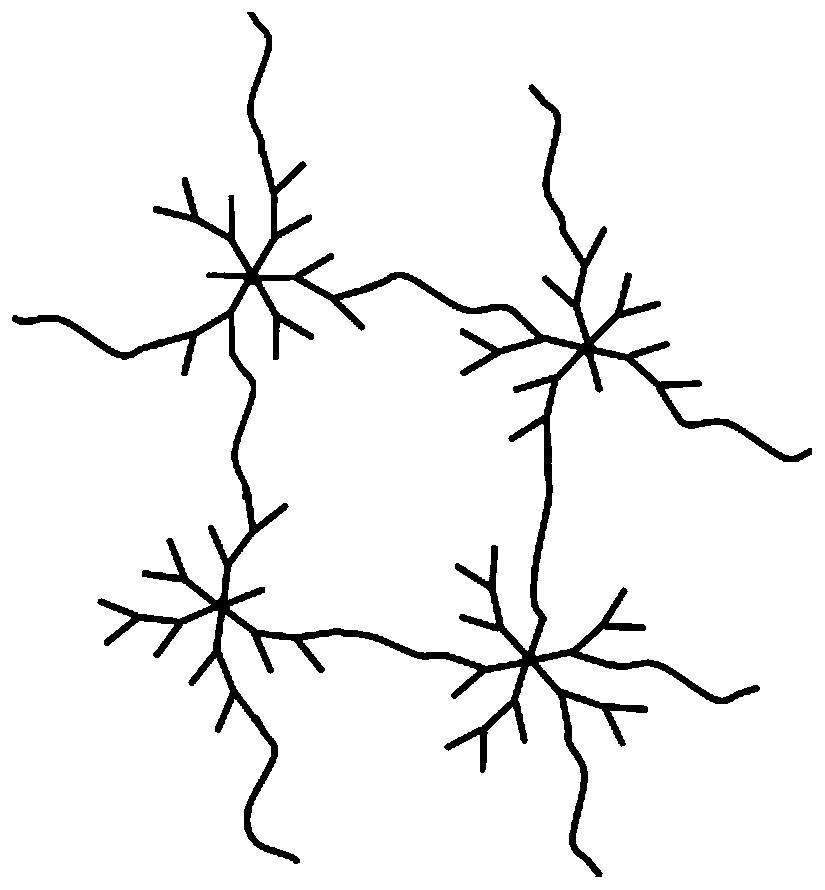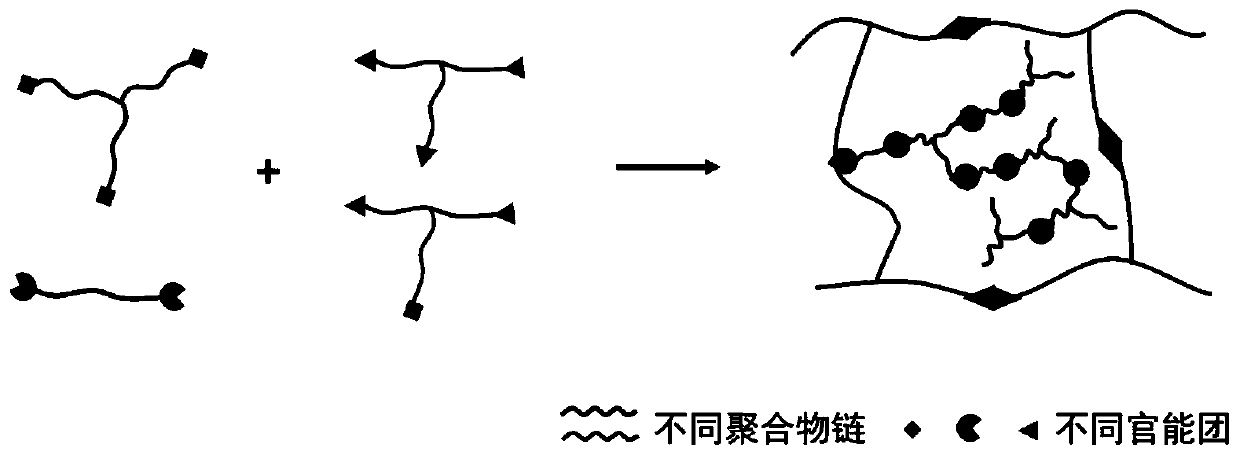Preparation method of topological elastomer with highly branched structure and low modulus and high elasticity
A highly branched and elastomeric technology, applied in the field of preparation of topological elastomers, can solve problems such as difficult to prepare, performance-limited rigid molecular chains, low modulus, etc., and achieve low equipment requirements, diverse polymerization methods, and simple operation Effect
- Summary
- Abstract
- Description
- Claims
- Application Information
AI Technical Summary
Problems solved by technology
Method used
Image
Examples
Embodiment 1
[0053] Embodiment 1 (direct cross-linking method prepares topological elastomer)
[0054] The raw material of embodiment 1 and source are as shown in table 1:
[0055] Table 1 Embodiment 1 Raw materials and source
[0056]
[0057]
[0058] Preparation of topological elastomers:
[0059] Weigh the sample according to the ratio of PCL, pentaerythritol triacrylate and HDI at 1:0.5:1 (molar ratio), and dissolve it in an appropriate amount of butyl acetate. After stirring evenly, 0.5wt% of DBTDL and 1wt% of AIBN were added in sequence, and the mixture was poured into a mold, and reacted under heating at 70°C for 3h. After evacuating the solvent in a vacuum oven, the cross-linked topological elastomer can be obtained.
[0060] The mechanical properties of materials can be tested using a universal testing machine. The modulus, elongation at break and elastic recovery properties of the material can be calculated from the tensile curve. The obtained topological elastomer ha...
Embodiment 2
[0061] Embodiment 2 (post-crosslinking method, self-polymerization of dendritic branched macromolecules to form topological elastomers)
[0062] The raw material of embodiment 2 and source are as shown in table 2:
[0063] Table 2 Embodiment 2 raw materials and source
[0064]
[0065] Preparation of dendritic branched macromolecules whose end groups are methacrylate groups:
[0066] 1. Weigh the sample according to the ratio of triallylamine and allyl acrylate of 1:6 (molar ratio), stir evenly, add 5wt% triethylamine to catalyze and react for 1h;
[0067] 2. Then, add β-mercaptoethylamine of the same molar amount as allyl acrylate, 1wt% photoinitiator, and under 365nm ultraviolet light irradiation, under heating at 40°C, β-mercaptoethylamine dissolves while reacting;
[0068] 3. After the complete reaction of β-mercaptoethylamine, add allyl acrylate twice as much as that added in step 1, and then repeat step 1;
[0069] 4. Add 2 times the amount of β-mercaptoethylamine ...
Embodiment 3
[0076] Embodiment 3 (post-crosslinking method, two kinds of dendritic branched macromolecules are copolymerized into topological elastomers)
[0077] The raw material of embodiment 3 and source are as shown in table 3:
[0078] Table 3 Embodiment 3 raw materials and sources
[0079]
[0080]
[0081] Preparation of dendritic branched macromolecules whose terminal groups are amino groups:
[0082] 1. First, weigh the sample according to the ratio of triallylamine and allyl acrylate to 1:6 (molar ratio) and stir evenly, then add 5wt% triethylamine to catalyze and react for 1 hour;
[0083] 2. Then, add β-mercaptoethylamine of the same molar amount as allyl acrylate, 1wt% photoinitiator, and under 365nm ultraviolet light irradiation, under heating at 40°C, β-mercaptoethylamine dissolves while reacting;
[0084] 3. After the complete reaction of β-mercaptoethylamine, add allyl acrylate twice as much as that added in step 1, and then repeat step 1;
[0085] 4. Add 2 times ...
PUM
| Property | Measurement | Unit |
|---|---|---|
| modulus | aaaaa | aaaaa |
| modulus | aaaaa | aaaaa |
| modulus | aaaaa | aaaaa |
Abstract
Description
Claims
Application Information
 Login to View More
Login to View More - R&D
- Intellectual Property
- Life Sciences
- Materials
- Tech Scout
- Unparalleled Data Quality
- Higher Quality Content
- 60% Fewer Hallucinations
Browse by: Latest US Patents, China's latest patents, Technical Efficacy Thesaurus, Application Domain, Technology Topic, Popular Technical Reports.
© 2025 PatSnap. All rights reserved.Legal|Privacy policy|Modern Slavery Act Transparency Statement|Sitemap|About US| Contact US: help@patsnap.com



